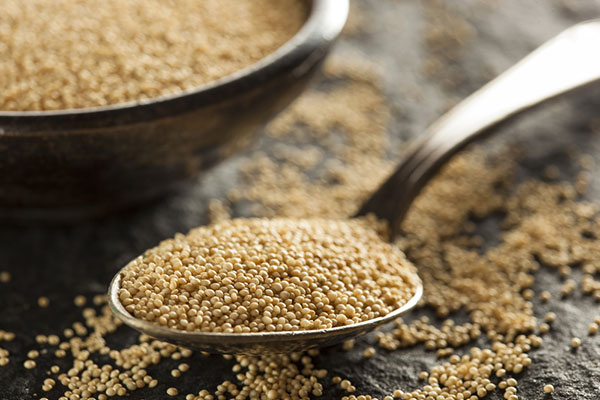Whether you’re going gluten-free and need a change of pace from quinoa and potatoes, or you’re just looking to add more nutrient-dense grains to your dinner routine, you’ve got more options than you may have thought! Here are nine new-to-you (yet very old!) options you’ve probably never heard of or tried. They are certainly worth becoming more familiar!
1. Amaranth
Aztecs ate amaranth for thousands of years–and for good reason! One cup of cooked amaranth has 9 grams of protein and 29% of your daily iron.
How to Eat It: Boil one cup grains in 6 cups water for 40 minutes, then drain off excess water. Use it in tabouli salad instead of bulgur, or with bananas and cinnamon as an alternative to oatmeal.
2. Buckwheat
Believe it or not, there is no wheat found in buckwheat. It’s actually a fruit seed originally from China. Kasha is the roasted kernel form that we eat. One cooked cup has only 155 calories, 1 gram of fat, and 5 grams of fiber to keep you feeling full.
How to Eat It: Stir-fry 100% buckwheat (soba) noodles with shrimp and veggies, or cook buckwheat groats (kasha) like rice and add lemon, olive oil, and fresh herbs.
3. Teff
If you’ve eat Ethiopian food, you’ve tried endear, a spongy crepe-like bread made from teff. This forgotten grain is loaded with protein at 10 grams per cup, and has a high percentage of vitamin B1.
How to Eat it: Add teff flour with other gluten-free flours in pancakes or as a soup thickener. Also try teff grains as a creamy polenta with mushrooms and tomatoes.
4. Millet
Eating healthy sometimes looks like rabbit food. Gluten-free eating looks like bird food. And it is! Ever buy birdseed? The little light colored pellets are millet, a nutritional powerhouse packed with manganese that is just as important for humans as it is for animals.
How to Eat it: Buy pre-made puffs for cereal, use as a stuffing for peppers or chicken, or combine with beans, onions and spices for a veggie burger.
5. Sorghum
Native to Africa, this offbeat option is high in antioxidants and can be turned into a sweet flour alternative, or into a low glycemic syrup.
How to Eat It: Replace wheat flour with sorghum flour in baked goods, or combine cooked sorghum with beans and kale for a pilaf.
6. Forbidden Rice
When raw, it starts out a deep black color, and changes to a bright purple once it’s cooked. A 2025 study in the journal Circulation found that middle-aged women with high consumption of forbidden rice (and other anthocyanin-rich foods) were 32% less likely to suffer heart attacks.
How to Eat it: Stir in coconut milk for a sweet rice pudding, or stir-fry with eggs, scallions, and soy sauce
7. Job’s Tears
Also called Coix Seeds or Chinese barley, this chewy grain is teardrop-shaped and often used to treat cancer in China.
How to Eat it: Perfect for soups and stews, or added to wild rice and mushrooms then stuffed into butternut squash.
8. Bhutan Red Rice
Native to the Himalayas and taking only 20 minutes to prepare, cooked red rice is low in calories and high in protein, fiber, phosphorus, manganese, and magnesium. In other words, it’s loaded in good-for-you nutrients.
How to Eat it: Steam like regular rice, or toss with nuts and dried fruit for a sweet-savory pilaf.
9. Blue Cornmeal
A staple of Southwestern Native Americans, blue corn is a bit sweeter than yellow cornmeal, and also has more protein and fiber.
How to Eat it: Sub in wherever you’d use yellow cornmeal: muffins, blue corn polenta, or this Vegan Blue Cornbread!
Also Read:
How to Eat Gluten-Free Desserts
Breaking Bread: Drew Manning’s 4-Month Gluten-Free Diet Experiment to Bust the Hype

